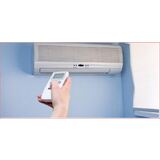Energy efficiency vs under-consuming – the difference can be deadly.
Author: https://reneweconomy.com.au/ Date Posted:9 March 2020

The following article was selected as runner up (student) in the 2019 Gill Owen Essay Prize, which honours the memory of Dr Gill Owen, who was a tireless campaigner in the fields of energy efficiency and social equity. Dr Owen was also one of the first women to bring the voices of the consumer and the disadvantaged to the boards of the UK’s and Australia’s competition and economic regulators. The competition was sponsored by AGL Energy, the Institute for Sustainable Futures at UTS, the Association for Environmental and Energy Equity, Uniting Communities and RenewEconomy.
The easiest way to reduce your electricity bill is to reduce your consumption. But what if this is not a simple choice? What if turning off your fan, air-conditioning unit or evaporative cooling system, could potentially be a lethal decision?
In Tamworth, the sky is a raw blue. As early as September a savage heat descends on the town. With the drought staggering on for yet another year, the fields are bare, swept clear of topsoil so only rock remains. Trees stand limply, casting thin shadows.
It’s hard to look at the NSW Drought map. Large sections of the state have been coloured a deep rusty red. As of November 2019, 93.2% of the north-west region, the region where I live, has been categorised as having ‘intense drought’ conditions. This is the highest category on the scale. And the outlook remains dire.
A couple of weeks ago, the Bureau of Meteorology released their climate forecast for the summer months. They reported that “daytime temperatures are likely to be above average across Australia for the remainder of 2019 and into early 2020.” Along with this heat, November and December rainfall was also forecast to be below average.
And so, as the temperatures across the New England region continue to rise without relief, staying cool becomes a matter of survival.
Some parts of our communities – the elderly, the young, the unwell – are more vulnerable to the extremes of the weather. And yet, these groups typically have the least amount of resources. The risk of ‘under-consuming’ is high, with some people not cooling their houses in order to keep their electricity bills at manageable levels.
In response to widespread complaints about energy prices, the Australian Government created a guide called ‘Reduce Energy Bills’. The advice available from the Department of the Environment and Energy’s website is written in Plain English. And yet, as I read through it, I can’t help but analyse their recommendations as a physiotherapist.
I’ve been trained to think about how people move through the world, and these tips are largely impractical for bodies that are elderly, frail or disabled.
The Department strongly advises consumers to: ‘Target the biggest sources of energy use around your home first, such as hot water and heating and cooling.’ The website goes on to suggest that people should avoid using hot water and appliances during peak hours (between 7am to 10pm).
But what if you are relying upon paid carers to assist you with personal hygiene tasks? Or require domestic cleaning services, such as someone to vacuum your floors or do your laundry? Care services are generally only offered during business hours.
Next up, the Department advises consumers to switch off power points when they are not in use. At first this seems like sensible, even easy, advice. But often power points are located in corners or close to skirting boards. I try not to think about my elderly clients – whose balance and mobility is often limited – bending down to switch off power points. Their risk of falling is frighteningly high.
Other suggestions on the website include home improvements, such as installing extra insulation or hanging thicker curtains. These modifications are often out of reach for those living on the disability and aged care pensions. And so, with few choices to lower their energy usage, I often hear elderly clients saying that they’re not using fans and air conditioners.
This is not uncommon. According to a survey from The Conversation’s ‘Heatwaves, Homes & Health’ research project: ‘Professionals who work with vulnerable households worried that electricity costs were affecting their clients’ health. The vast majority – 88 per cent of those surveyed – reported that they knew of households with very young, old or ill members who did not use air conditioning during heatwaves, most commonly because of electricity cost.’
The symptoms of heat stress begin mildly. Starting with dizziness, tiredness, nausea, headaches and cramping. If left untreated, these symptoms rapidly intensify, causing individuals to become increasingly irrational. Consequently, simple actions such as – applying a cool towel, changing into loose clothing, turning on a fan or ringing an ambulance – can go unperformed. Heatstroke is fatal in up to 80 per cent of cases, which means heat kills more Australians than any natural disaster.
So while it is important to educate Australians about thrifty power usage, it is equally important to recognise that inequities exist. Some people have limited control over accessing energy during off-peak periods. There also needs to be considerations about how advice regarding power conservation is framed.
The Heatwaves, Home & Health project found that “advice to conserve power during the 2014 Victorian heatwave reportedly caused some of the most vulnerable households to restrict use of air conditioners.”
The researchers believe that elderly people acted out of a sense of civic duty, despite it placing their health at risk. With another long, stark summer ahead, heat is a public health crisis that needs fair solutions that keep the vulnerable safe.
Long before that research was released, Dr Gill Owen was one of the first people to write about the social inequities of energy consumption.
In her 2013 report Addressing Peak Demand: the opportunities and risks for vulnerable households Dr Owen writes: “There is growing consensus on the need to tackle peak demand. This paper seeks to inform the debate by identifying potential impacts of solutions to the peak demand problem on vulnerable households and making some recommendations.”
By focusing first on social inequality before leaping to recommendations, Dr Owen’s report has a timeless quality. Her arguments are continually centred on humanity, which in turn exposes the complexities of life.
This holistic approach to policy is evident in her nuanced analysis of energy vulnerability, and how “state-based electricity concessions” can fail to consider all the factors that can influence household energy consumption.
She writes: “Vulnerability may therefore be visible (e.g. debt and difficulty paying bills) or hidden (e.g. households who over-economise – and potentially risk their health).”
The NSW Energy Rebates system is an example of a state-based electricity concession program which, while it provides some assistance, is an imperfect solution.
There are two options. The Seniors Energy rebate is capped at $200 per household, per financial year. While the Medical Energy Rebate is available to individuals who have “an inability to self-regulate body temperatures when exposed to extreme hot or cold environmental temperatures.”
Applicants for this option require a medical diagnosis before they can receive a rebate of up to $285 per year. This rebate cannot be accessed if you hold a Commonwealth Seniors Health Card.
As a health care professional, I find the disparity between the two rebates confusing.
Research shows that the risk of heat stress increases for anyone aged over 75-years-old. It seems pertinent that seniors should be able to access the same amount of money as the Medical Energy Rebate.
There is also the issue of eligible people having to apply for the rebates every year. This, in itself, may prove to be a barrier, particularly for those with reduced mobility, poor computer literacy or limited transport options.
For those aged over 75- years-old, as well as those with lifelong medical conditions affecting their thermo-regulation, the rebates should simply be ongoing.
Overall, there should be more options and support for vulnerable households, particularly those who have limited resources or abilities to enact so-called ‘basic’ energy-saving advice.
There have been far too many preventable deaths from heat. And as temperatures continue to soar, the conversation about energy efficiency and consumption must always begin from a place of compassion, rather than leapfrogging to solutions.



